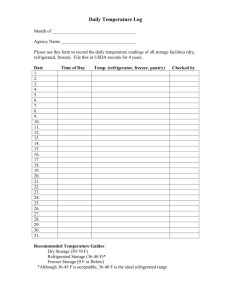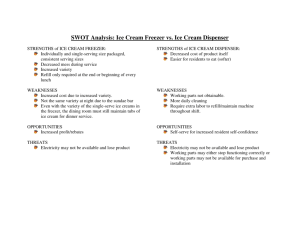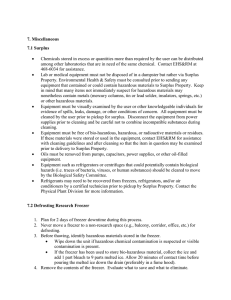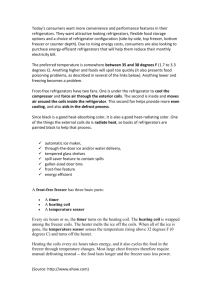Flavored Vinegars if the Preserving Food:
advertisement
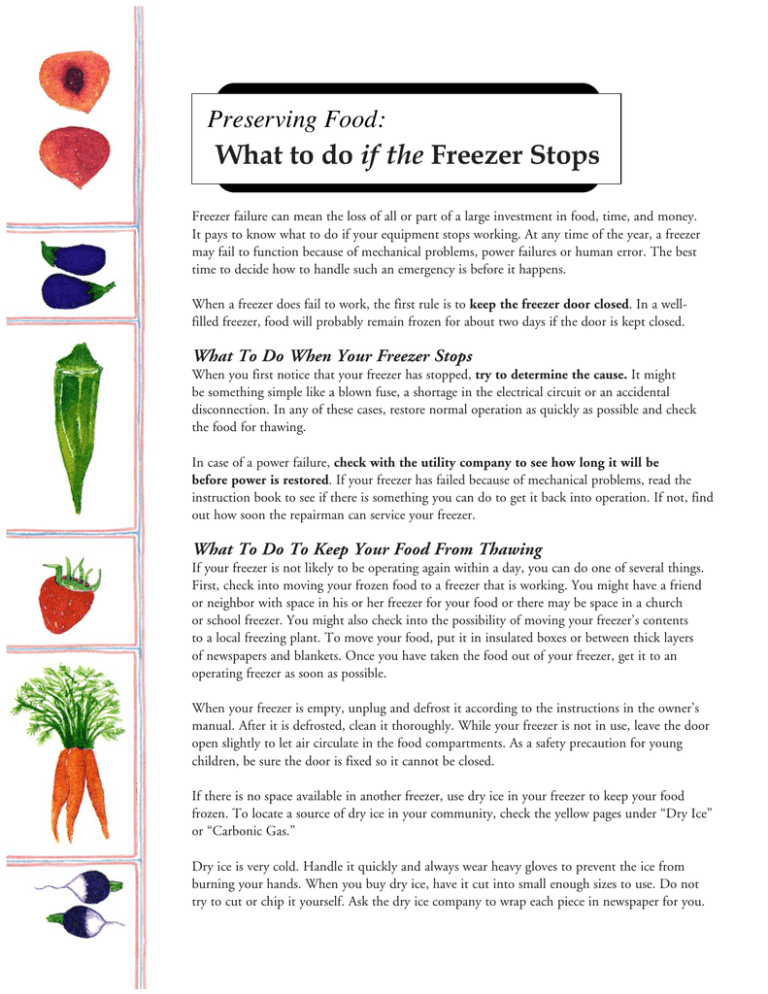
Preserving PreservingFood: Food: What What to to dodo if the ifVinegars the Freezer Freezer Stops Stops Flavored Flavored Vinegars Freezer failure can mean the loss of all or part of a large investment in food, time, and money. It pays to know what to do if your equipment stops working. At any time of the year, a freezer may fail to function because of mechanical problems, power failures or human error. The best time to decide how to handle such an emergency is before it happens. When a freezer does fail to work, the first rule is to keep the freezer door closed. In a wellfilled freezer, food will probably remain frozen for about two days if the door is kept closed. What To Do When Your Freezer Stops When you first notice that your freezer has stopped, try to determine the cause. It might be something simple like a blown fuse, a shortage in the electrical circuit or an accidental disconnection. In any of these cases, restore normal operation as quickly as possible and check the food for thawing. In case of a power failure, check with the utility company to see how long it will be before power is restored. If your freezer has failed because of mechanical problems, read the instruction book to see if there is something you can do to get it back into operation. If not, find out how soon the repairman can service your freezer. What To Do To Keep Your Food From Thawing If your freezer is not likely to be operating again within a day, you can do one of several things. First, check into moving your frozen food to a freezer that is working. You might have a friend or neighbor with space in his or her freezer for your food or there may be space in a church or school freezer. You might also check into the possibility of moving your freezer’s contents to a local freezing plant. To move your food, put it in insulated boxes or between thick layers of newspapers and blankets. Once you have taken the food out of your freezer, get it to an operating freezer as soon as possible. When your freezer is empty, unplug and defrost it according to the instructions in the owner’s manual. After it is defrosted, clean it thoroughly. While your freezer is not in use, leave the door open slightly to let air circulate in the food compartments. As a safety precaution for young children, be sure the door is fixed so it cannot be closed. If there is no space available in another freezer, use dry ice in your freezer to keep your food frozen. To locate a source of dry ice in your community, check the yellow pages under “Dry Ice” or “Carbonic Gas.” Dry ice is very cold. Handle it quickly and always wear heavy gloves to prevent the ice from burning your hands. When you buy dry ice, have it cut into small enough sizes to use. Do not try to cut or chip it yourself. Ask the dry ice company to wrap each piece in newspaper for you. Vegetables: Re-freeze only if ice crystals are still present or if the freezer temperature is 40°F or below. Discard any packages that show signs of spoilage or that have reached room temperature. A 50-pound cake of dry ice is enough to protect solidly frozen food in a full 20-cubic foot freezer for three to four days. A 25-pound cake should hold the temperature of a half- full, 10-cubic foot freezer below freezing for two to three days. Fruits: Re-freeze if they show no signs of spoilage. Thawed fruits may be used in cooking or making jellies, jams, or preserves. Fruits survive thawing with the least damage to quality. Put heavy cardboard on top of packages of frozen food in each compartment of your freezer and put the dry ice on top of the cardboard. Close the freezer, but do not lock it. Do not open the freezer again until you need to replace the dry ice or the freezer is working again. You can provide extra insulation for your freezer by covering it with blankets or quilts. Putting packaging material or crumpled newspapers between the cabinet and the blankets will also help. Be sure, however, to fasten coverings away from the air vents on the outside of the freezer. The power may come on unexpectedly and ventilation will be needed. The harmless gas given off by the dry ice also needs to escape. Shellfish and Cooked Foods: Re-freeze only if ice crystals are still present or the freezer is 40°F or below. If the temperature is above 40° F, throw these foods out. Ice Cream: If partially thawed, throw it out. The texture of ice cream is not acceptable after thawing. If its temperature rises above 40°F, it could be unsafe. Creamed Foods, Puddings and Cream Pies: Re-freeze only if freezer temperature is 40°F or below. Discard if the temperature is above 40°F. Dry ice is carbon dioxide in its solid form. It evaporates rather than melts and leaves no liquid. You may notice an off odor caused by carbonic acid, which is formed by the dry ice and moisture in the freezer. It is harmless. Simply leave the freezer door open a few minutes to let it escape. Breads, Nuts, Doughnuts, Cookies and Cakes: These foods re-freeze better than most. They can be safely re-frozen if they show no signs of mold growth. What To Do To Plan Ahead What To Do With Thawed Food Some thawed foods can be re-frozen. However, the texture will not be as good. Other foods may need to be discarded. Here are some guidelines: To be prepared in case your freezer stops, plan ahead. Find out where the nearest commercial or institutional freezers are. Locate a source of dry ice. Meat and Poultry: Re-freeze if the freezer temperature stays 40°F or below and if color and odor are good. Check each package, and discard any if signs of spoilage such as an off color or off odor are present. Discard any packages that are above 40°F (or at room temperature). During the seasons when power failures are frequent or if you know the power will be off, it is good insurance to run the freezer between -10°F and -20°F. The colder the food, the more slowly it thaws. Edited by Judy A. Harrison, Ph.D., Extension Foods Specialist and Elizabeth L. Andress, Ph.D., Extension Food Safety Specialist. The University of Georgia and Ft. Valley State University, the U.S. Department of Agriculture and counties of the state cooperating. The University of Georgia Cooperative Extension and the Colleges of Agricultural and Environmental Sciences & Family and Consumer Sciences offer educational programs, assistance and materials to all people without regard to race, color, national origin, age, sex or disability. An Equal Opportunity Employer/Affirmative Action Organization Committed to a Diverse Work Force FDNS-E-43-6 Reviewed June 2011 2
